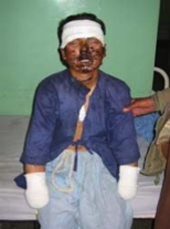July 2007
How your contribution can provide eye surgery to children and adults where the preventable blindness rate is the highest in the world.
Afghanistan has been torn by war and civil unrest for over thirty years, and although there have been significant improvements since 2001, it remains one of the world’s poorest and least developed countries. What little infrastructure the country possessed has mostly been destroyed and will take years to rebuild.
One of the greatest challenges facing Afghanistan is the lack of adequate health care. One group who suffers greatly from this lack is the blind. Afghanistan has the highest rate of preventable blindness in the world—it affects between one and two percent of the population. Since 1966 the International Assistance Mission, a Christian humanitarian aid agency, has provided most of the eye care service throughout Afghanistan.
The benefits to a community from good eye care are enormous because blindness restricts people’s ability to work or participate in social life. Most often, a blind person requires someone to take care of him all of the time. When a child has to stay home from school to lead a blind parent or grandparent around, his or her chances of going to school are reduced to almost nothing. The consequences of being blind in Afghanistan are significantly greater than in developed countries, where Seeing Eye dogs, roadside curbs, signs in Braille and other aids help make life more bearable. Afghanistan has few sidewalks, let alone paved roads, so the blind are forced to deal with cars, trucks, buses, horses, donkeys and sheep on the roads, putting them at risk for a variety of injuries and increased suffering.
One of the most common preventable causes of blindness in Afghanistan is cataracts. A victim of cataracts not only suffers himself, he is a burden on the family’s resources and to society in general. But that same person, if he has access to good eye care and cataract surgery, can become a contributing member of his family and of society.
Remarkable Results, yet Crying Needs
In 2006 IAM treated more than 277,000 out-patients and performed some 16,000 sight-saving surgeries. However, even this heroic effort did not meet the incredible need. Afghanistan’s population is 25 million, and the World Health Organization estimates that one thousand people out of every million in Afghanistan are going blind because of cataracts. To meet this need, an additional 25,000 cataract surgeries must be performed every year. This is a tremendous challenge because 75-80% of the people live in rural areas and do not have easy access to eye care facilities. The rugged country-side, poor or nonexistent roads, and the general instability of the country make it necessary to set up eye care facilities throughout the country.
The subsidized cost of a sight-saving cataract surgery at an IAM facility is only $30, which includes both the surgery and postoperative care. However, many people cannot afford even this small amount of money. Because it is their policy to help those in need regardless of their ability to pay, IAM never turns anyone away who cannot afford surgery. To be able to continue to help those who are destitute, IAM has established a cataract surgery fund.
Please Help Restore Sight to the Blind!
This tremendous challenge presents us as Christians with a great opportunity to show God’s love in a tangible way to the Afghan people. Will you join us by helping IAM cover some of the cost of their great work? All of the IAM expatriate staff are volunteers, and no donations are used to pay for their living expenses. All funds will be used to help cover the cost of cataract surgery for those who otherwise could not get it because they are too poor.
Please consider making a donation to provide sight to those who cannot see.
Thank you and God bless you,
Alec Brooks




